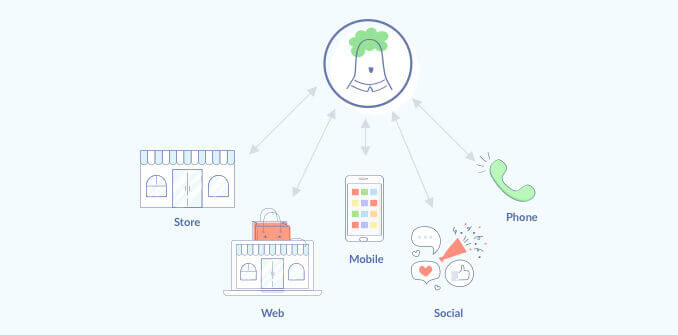

In today’s customer-centric world, providing exceptional customer support is more important than ever. Customers expect timely, personalized, and effective solutions across multiple channels. A multichannel customer support platform helps businesses meet these demands by offering a seamless experience across various communication channels, such as email, chat, social media, and phone. This post will explore how multichannel platforms can elevate customer support, improve customer satisfaction, and ultimately enhance business success.
What is a Multichannel Customer Support Platform?
A multichannel customer support platform is a software solution that allows businesses to manage customer interactions across various communication channels. These platforms integrate different touchpoints—such as email, phone, live chat, social media, and messaging apps—into a single interface, enabling customer service teams to respond to customer inquiries efficiently. The main goal of these platforms is to provide a unified experience for customers while allowing agents to manage support requests from multiple channels in one place.
Key Benefits of Multichannel Platforms for Customer Support
1. Improved Customer Satisfaction
Customers today expect fast and convenient ways to get in touch with businesses. By offering multiple communication channels, businesses can cater to diverse customer preferences and improve the chances of resolving issues faster. Customers appreciate the flexibility of choosing the channel that best fits their needs—whether it’s a quick message on social media or a more detailed conversation over the phone.
2. Streamlined Communication
A multichannel platform allows customer service agents to view and manage all customer interactions in one centralized location. Whether a customer reaches out via email, live chat, or social media, agents can access the complete communication history, making it easier to provide informed and consistent responses. This reduces the chances of miscommunication and ensures a more efficient service process.
3. Enhanced Team Collaboration
Multichannel platforms often include collaboration tools that allow agents to work together in real-time. For example, team members can share notes, tag colleagues for assistance, or transfer tickets to the right department. This fosters a collaborative environment and enables customer support teams to work more effectively together, leading to quicker resolutions and higher-quality customer service.
4. Increased Efficiency and Productivity
Managing all customer inquiries through a single platform increases efficiency and saves time. Instead of switching between different systems to handle support requests, agents can streamline their workflow by handling everything from one unified platform. Automation features, such as automated responses and ticket routing, further enhance efficiency by reducing manual tasks and ensuring that customers are directed to the right person immediately.
Key Features to Look for in a Multichannel Customer Support Platform
1. Omnichannel Integration
Ensure the platform can integrate with various communication channels, including email, live chat, social media (Facebook, Twitter, Instagram), SMS, and messaging apps (WhatsApp, Messenger). This way, customers can reach out through their preferred channel, and support teams can respond from one unified interface.
2. Automation Capabilities
Look for features like automated responses, ticket creation, and workflows. Automation can help resolve simple inquiries instantly, reduce response times, and free up agents to focus on more complex issues. Automated ticket routing ensures that customers are connected to the right department, reducing delays and frustration.
3. Real-Time Analytics and Reporting
A good multichannel platform should offer real-time analytics that tracks key performance indicators (KPIs), such as response times, customer satisfaction, and ticket resolution rates. These insights enable businesses to identify trends, monitor agent performance, and continuously improve the customer support experience.
4. Customer Feedback Tools
Incorporating customer feedback tools—such as post-interaction surveys—into the platform enables businesses to measure customer satisfaction and identify areas for improvement. This helps businesses gather valuable insights directly from customers and use the data to enhance their support strategies.
How to Implement a Multichannel Platform for Customer Support
1. Assess Your Current Customer Support Channels
Before implementing a multichannel platform, assess the communication channels your customers are currently using to reach your support team. Whether it’s social media, email, or phone calls, understanding your customers’ preferences helps you choose the right platform and integrate it effectively.
2. Select the Right Platform for Your Business
There are various multichannel platforms available, each offering different features and integrations. Choose a platform that meets your business’s specific needs, budget, and customer support volume. Look for a solution that offers easy scalability as your business grows.
3. Train Your Team
Once you’ve selected the platform, it’s time to train your customer support team on how to use it effectively. Ensure they understand the different channels and how to respond to inquiries promptly and professionally. Training on using the platform’s automation tools and collaboration features will help your team manage support requests more efficiently.
4. Monitor and Optimize
Once the platform is up and running, monitor the performance of your customer support team and gather feedback from customers. Use analytics to identify areas where response times could be improved, customer satisfaction could be enhanced, or processes could be optimized. Regularly reviewing and adjusting your approach will help you provide the best possible support.
Best Practices for Elevating Customer Support with Multichannel Platforms
1. Offer Personalized Support
Customers appreciate when they are treated as individuals. Use the data available within your multichannel platform to personalize interactions, such as referring to past issues or recognizing previous interactions. Personalized support makes customers feel valued and builds stronger relationships.
2. Maintain Consistency Across Channels
Ensure that your team delivers consistent responses across all channels. Whether a customer reaches out via social media or live chat, the tone, solutions, and overall experience should be similar. This helps build trust and avoids confusion for customers who may use multiple channels to interact with your business.
3. Respond Quickly and Effectively
Customers expect fast responses, especially in today’s digital world. Strive to provide timely solutions to inquiries, whether it’s through automated responses for common questions or quick follow-ups for more complex issues. Aim to resolve issues on the first contact whenever possible.
4. Encourage Self-Service Options
While a multichannel platform enables easy communication, providing self-service options can reduce the need for customers to contact support in the first place. Offer a comprehensive knowledge base, FAQs, or troubleshooting guides that empower customers to find answers independently.
Conclusion
Multichannel customer support platforms are revolutionizing the way businesses interact with their customers. By offering a seamless experience across multiple channels, businesses can improve customer satisfaction, streamline communication, and increase team collaboration. With the right multichannel platform, you can ensure your team is always equipped to provide fast, personalized, and effective support.

Leave a Reply